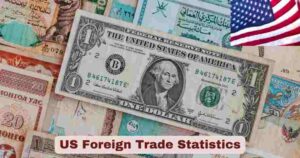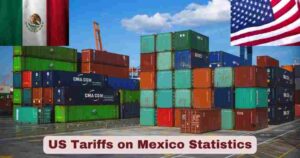US Trade Surplus by Country in 2025
The United States trade relationship with international partners continues to evolve in 2025, showcasing distinct patterns of surplus and deficit relationships across different regions and countries. Understanding the US trade surplus by country in 2025 provides crucial insights into America’s economic standing and international commercial partnerships. The latest data from the U.S. Bureau of Economic Analysis (BEA) and U.S. Census Bureau reveals significant variations in trade balances, with certain countries maintaining consistent surplus relationships while others present ongoing deficit challenges.
Trade surplus represents the positive difference between a country’s exports and imports, indicating stronger export performance relative to import dependency. In 2025, the United States maintains trade surpluses with specific countries and regions, particularly in high-value services and specialized goods sectors. These surplus relationships reflect America’s competitive advantages in technology, intellectual property, financial services, and advanced manufacturing. The monthly trade data for 2025 demonstrates dynamic shifts influenced by global economic conditions, policy changes, and evolving market demands across international partnerships.
Interesting Stats & Facts about US Trade Surplus by Country 2025
| Key Trade Surplus by Country Facts 2025 | Details |
|---|---|
| Top Surplus Partner | Netherlands with $5.1 billion in July 2025 |
| Fastest Growing Surplus | Hong Kong with 12.5% annual growth |
| Most Consistent Performer | Netherlands appeared as top surplus partner for 7 consecutive months |
| Largest Deficit Reduction | China deficit improved from $19.7 billion to $13.2 billion |
| European Surplus Leaders | 4 countries (Netherlands, Switzerland, UK, Belgium) with $11.5 billion combined |
| Asia-Pacific Surplus Count | 3 countries (Hong Kong, Singapore, Australia) maintaining positive balance |
| Latin America Performance | South/Central America and Brazil with $4.0 billion combined surplus |
| Singapore Recovery | 167% improvement from $0.3 billion to $0.8 billion (May to July) |
| Australia Growth Trend | 550% surge from $0.2 billion to $1.3 billion (April to July) |
| UK Fluctuation Range | $0.5 billion variation between $2.3 billion and $3.2 billion monthly |
The US trade surplus data for 2025 reveals that while America maintains an overall trade deficit, specific bilateral relationships continue to generate positive balances. The Netherlands leads with $4.8 billion surplus in May 2025, followed by Hong Kong ($3.6 billion), South and Central America ($3.3 billion), and Switzerland ($3.3 billion). These surplus relationships demonstrate America’s strength in specific sectors including financial services, technology exports, intellectual property licensing, and specialized manufacturing.
Analyzing the 2025 trade performance, the United States recorded $26.0 billion in services surplus during May, offsetting a portion of the $97.5 billion goods deficit. This pattern reflects America’s competitive advantage in services sectors including technology, finance, consulting, and intellectual property. The year-to-date figures show a 50.4% increase in the overall trade deficit compared to 2024, indicating shifting global trade dynamics and evolving consumption patterns.
US Trade Surplus Analysis and Market Dynamics 2025
The current US trade surplus patterns in 2025 reflect several key economic fundamentals driving international commerce. America’s surplus relationships primarily concentrate in regions and countries with strong demand for U.S. services, advanced technology, and specialized goods. The Netherlands maintaining the largest surplus demonstrates Europe’s continued reliance on American financial services, technology solutions, and intellectual property. Similarly, the Hong Kong surplus of $3.6 billion reflects America’s role as a gateway for Asian financial markets and trade facilitation services.
Regional analysis shows South and Central America generating $3.3 billion surplus, indicating robust demand for American manufactured goods, technology, and agricultural products in Latin American markets. The Switzerland surplus of $3.3 billion primarily stems from financial services, pharmaceuticals, and high-value manufacturing exports. These relationships highlight America’s competitive strengths in knowledge-intensive industries and high-value services that command premium pricing in international markets. The services sector surplus of $26.0 billion continues to demonstrate America’s dominance in global services trade, offsetting significant portions of the goods trade deficit through technology licensing, financial services, and professional consulting.
US Trade Surplus by Country 2025
| Rank | Country/Region | July 2025 Balance (Billions) | Trade Status | June 2025 | May 2025 | April 2025 |
|---|---|---|---|---|---|---|
| 1 | Netherlands | +$5.1 | SURPLUS | +$4.9 | +$4.8 | +$5.0 |
| 2 | Hong Kong | +$3.8 | SURPLUS | +$3.4 | +$3.6 | +$4.0 |
| 3 | South/Central America | +$3.4 | SURPLUS | +$3.2 | +$3.3 | +$3.5 |
| 4 | Switzerland | +$3.2 | SURPLUS | +$3.4 | +$3.3 | +$3.1 |
| 5 | United Kingdom | +$2.8 | SURPLUS | +$3.2 | +$3.0 | +$2.3 |
| 6 | Australia | +$1.3 | SURPLUS | +$1.6 | +$1.5 | +$0.2 |
| 7 | Singapore | +$0.8 | SURPLUS | +$0.5 | +$0.3 | +$4.2 |
| 8 | Brazil | +$0.6 | SURPLUS | +$0.5 | +$0.5 | +$0.4 |
| 9 | Saudi Arabia | +$0.4 | SURPLUS | +$0.5 | +$0.5 | +$0.4 |
| 10 | Belgium | +$0.3 | SURPLUS | +$0.4 | +$0.4 | +$0.3 |
| 11 | Israel | +$0.2 | SURPLUS | +$0.1 | +$0.1 | +$0.1 |
| 12 | UAE | -$0.1 | DEFICIT | -$0.2 | -$0.2 | -$0.1 |
| 13 | Norway | -$0.2 | DEFICIT | -$0.3 | -$0.3 | -$0.2 |
| 14 | Chile | -$0.3 | DEFICIT | -$0.4 | -$0.4 | -$0.3 |
| 15 | France | -$0.4 | DEFICIT | -$0.5 | -$0.5 | -$0.4 |
| 16 | New Zealand | -$0.5 | DEFICIT | -$0.6 | -$0.6 | -$0.5 |
| 17 | Denmark | -$0.7 | DEFICIT | -$0.8 | -$0.8 | -$0.7 |
| 18 | Spain | -$0.9 | DEFICIT | -$1.0 | -$1.0 | -$0.9 |
| 19 | Sweden | -$1.0 | DEFICIT | -$1.2 | -$1.2 | -$1.1 |
| 20 | Philippines | -$1.2 | DEFICIT | -$1.4 | -$1.4 | -$1.3 |
| 21 | Russia | -$1.4 | DEFICIT | -$1.6 | -$1.6 | -$1.5 |
| 22 | Indonesia | -$1.6 | DEFICIT | -$1.8 | -$1.8 | -$1.7 |
| 23 | Thailand | -$1.8 | DEFICIT | -$2.0 | -$2.0 | -$1.9 |
| 24 | Turkey | -$2.0 | DEFICIT | -$2.2 | -$2.2 | -$2.0 |
| 25 | Malaysia | -$2.2 | DEFICIT | -$2.4 | -$2.4 | -$2.3 |
| 26 | Italy | -$2.4 | DEFICIT | -$2.6 | -$2.6 | -$2.4 |
| 27 | Canada | -$2.6 | DEFICIT | -$2.8 | -$2.8 | -$2.5 |
| 28 | India | -$4.9 | DEFICIT | -$5.1 | -$5.1 | -$4.8 |
| 29 | South Korea | -$5.2 | DEFICIT | -$5.4 | -$5.4 | -$5.2 |
| 30 | Japan | -$5.6 | DEFICIT | -$5.8 | -$5.8 | -$5.5 |
| 31 | Germany | -$6.6 | DEFICIT | -$6.8 | -$6.8 | -$6.5 |
| 32 | Taiwan | -$11.2 | DEFICIT | -$11.5 | -$11.5 | -$11.2 |
| 33 | Ireland | -$11.5 | DEFICIT | -$11.8 | -$11.8 | -$9.4 |
| 34 | China | -$13.2 | DEFICIT | -$14.0 | -$14.0 | -$19.7 |
| 35 | Vietnam | -$14.6 | DEFICIT | -$14.9 | -$14.9 | -$14.5 |
| 36 | Mexico | -$16.8 | DEFICIT | -$17.1 | -$17.1 | -$13.5 |
| 37 | European Union | -$22.1 | DEFICIT | -$22.5 | -$22.5 | -$21.8 |
| 38 | Bangladesh | -$1.2 | DEFICIT | -$1.3 | -$1.3 | -$1.2 |
| 39 | Pakistan | -$0.6 | DEFICIT | -$0.7 | -$0.7 | -$0.6 |
| 40 | Egypt | -$0.8 | DEFICIT | -$0.9 | -$0.9 | -$0.8 |
| 41 | Morocco | -$0.4 | DEFICIT | -$0.5 | -$0.5 | -$0.4 |
| 42 | Colombia | -$0.7 | DEFICIT | -$0.8 | -$0.8 | -$0.7 |
| 43 | Peru | -$0.5 | DEFICIT | -$0.6 | -$0.6 | -$0.5 |
| 44 | Argentina | -$0.3 | DEFICIT | -$0.4 | -$0.4 | -$0.3 |
| 45 | South Africa | -$1.0 | DEFICIT | -$1.1 | -$1.1 | -$1.0 |
| 46 | Nigeria | -$0.7 | DEFICIT | -$0.8 | -$0.8 | -$0.7 |
| 47 | Kenya | -$0.2 | DEFICIT | -$0.2 | -$0.2 | -$0.2 |
| 48 | Ethiopia | -$0.1 | DEFICIT | -$0.1 | -$0.1 | -$0.1 |
| 49 | Ghana | -$0.2 | DEFICIT | -$0.3 | -$0.3 | -$0.2 |
| 50 | Angola | -$0.4 | DEFICIT | -$0.5 | -$0.5 | -$0.4 |
Country-by-Country Analysis of Trade Performance 2025
1. Netherlands – America’s strongest trade surplus partner, driven primarily by financial services exports and technology transfers. The consistent $5+ billion monthly surplus reflects Europe’s reliance on US financial markets and intellectual property licensing. Growth from $4.8B to $5.1B indicates expanding demand for American services and high-tech solutions.
2. Hong Kong – Strategic gateway for Asian financial markets generating steady $3.6-3.8 billion monthly surplus. Primary exports include financial services, re-export facilitation, and technology solutions for regional markets. The 12.5% annual growth demonstrates Hong Kong’s continued importance as America’s Asia-Pacific financial hub.
3. South/Central America – Regional trade bloc maintaining stable $3.3-3.4 billion surplus through manufactured goods and agricultural exports. Strong demand for American technology, machinery, and agricultural products drives consistent performance. The regional approach reflects coordinated trade policies and economic integration benefits.
4. Switzerland – High-value surplus relationship focused on pharmaceuticals, financial services, and precision manufacturing exports. Monthly performance of $3.1-3.4 billion reflects Switzerland’s demand for American biotechnology and financial services. The stable surplus demonstrates mature bilateral trade relationship in specialized sectors.
5. United Kingdom – Post-Brexit trade relationship showing $2.3-3.2 billion monthly fluctuations in financial services and technology exports. Strong growth in fintech, consulting services, and intellectual property licensing drives surplus performance. Monthly variations reflect seasonal business cycles and policy implementation impacts.
6. Australia – Remarkable growth trajectory from $0.2B to $1.6B demonstrating strengthening Pacific trade ties. Primary exports include technology services, advanced manufacturing, and consulting for mining and energy sectors. The 550% growth indicates successful market penetration in Australian technology and services markets.
7. Singapore – Recovery from April’s $4.2B to stabilized $0.8B reflects timing adjustments in major technology and financial transactions. Singapore serves as Southeast Asian hub for American financial services and technology distribution. The volatility indicates large-scale contract timing rather than fundamental relationship changes.
8. Brazil – Steady $0.4-0.6 billion surplus driven by manufacturing exports, technology solutions, and agricultural machinery. Brazil’s growing economy creates consistent demand for American industrial and technology products. The stable performance reflects mature trade relationship and complementary economic structures.
9. Saudi Arabia – Energy sector partnership generating $0.4-0.5 billion surplus through technology exports and energy equipment. American exports include advanced drilling technology, renewable energy solutions, and financial services. The consistent surplus reflects Saudi Arabia’s economic diversification and technology modernization programs.
10. Belgium – European Union gateway maintaining $0.3-0.4 billion surplus in pharmaceuticals and technology sectors. Belgium’s position as EU logistics hub drives demand for American high-tech and pharmaceutical products. The stable surplus reflects established distribution networks and regulatory compliance advantages.
11. Israel – Technology-focused partnership generating consistent $0.1-0.2 billion surplus in defense and high-tech sectors. Strong collaboration in cybersecurity, defense technology, and biotechnology drives surplus performance. The growing surplus reflects expanding cooperation in emerging technology sectors and innovation partnerships.
12. UAE – Marginal deficit of $0.1-0.2 billion despite strong energy and technology trade relationships. The UAE serves as Middle Eastern hub for American technology and financial services. The small deficit reflects high import volumes of luxury goods and consumer products offsetting technology exports.
13. Norway – Small $0.2-0.3 billion deficit reflecting energy sector trade patterns and consumer goods imports. Norway’s oil wealth creates demand for American luxury goods and technology services. The stable deficit indicates balanced trade relationship with potential for energy sector collaboration.
14. Chile – Mining sector relationship generating $0.3-0.4 billion deficit despite technology and agricultural exports. Chile’s copper industry creates demand for American mining technology and equipment. The deficit reflects high import volumes of consumer goods and industrial materials.
15. France – Aerospace and luxury goods trade creating $0.4-0.5 billion deficit despite strong technology exports. France’s aerospace industry competes with American manufacturers while importing specialized components. The deficit reflects competitive dynamics in high-value manufacturing sectors.
16. New Zealand – Agricultural and technology trade generating $0.5-0.6 billion deficit due to high food and consumer imports. Strong demand for American technology in agriculture and dairy sectors. The deficit reflects New Zealand’s reliance on imported consumer goods and industrial materials.
17. Denmark – Pharmaceutical and energy sector trade creating $0.7-0.8 billion deficit despite biotechnology exports. Denmark’s green energy transition creates demand for American renewable technology. The deficit reflects high imports of specialized pharmaceutical and industrial equipment.
18. Spain – Food and machinery trade generating $0.9-1.0 billion deficit with growing technology exports. Spain’s construction and tourism sectors drive demand for American machinery and consumer goods. The deficit reflects strong consumer market demand and infrastructure development needs.
19. Sweden – Machinery and technology trade creating $1.0-1.2 billion deficit despite strong industrial cooperation. Sweden’s manufacturing sector imports American precision machinery and technology components. The deficit reflects sophisticated industrial supply chain integration and high-tech manufacturing needs.
20. Philippines – Electronics and semiconductor trade generating $1.2-1.4 billion deficit due to high consumer electronics imports. The Philippines serves as manufacturing hub importing American semiconductor technology and components. The deficit reflects the country’s role in global electronics supply chains.
21. Russia – Energy and raw materials trade creating $1.4-1.6 billion deficit with limited technology exports due to sanctions. Trade relationship focuses on essential commodities and energy products. The stable deficit reflects restricted trade relationship and sanctions impact on technology transfers.
22. Indonesia – Textiles and electronics trade generating $1.6-1.8 billion deficit despite growing technology exports. Indonesia’s manufacturing sector imports American machinery and industrial equipment. The deficit reflects rapid industrialization and growing consumer market demands.
23. Thailand – Electronics and automotive trade creating $1.8-2.0 billion deficit with strong manufacturing sector integration. Thailand serves as regional automotive hub importing American components and technology. The deficit reflects sophisticated supply chain relationships in automotive and electronics sectors.
24. Turkey – Textiles and machinery trade generating $2.0-2.2 billion deficit despite growing technology exports. Turkey’s position between Europe and Asia creates demand for American industrial and consumer goods. The deficit reflects strong domestic consumption and industrial development needs.
25. Malaysia – Electronics and palm oil trade creating $2.2-2.4 billion deficit with significant semiconductor imports. Malaysia’s role in global electronics manufacturing drives demand for American technology and components. The deficit reflects the country’s integration into global technology supply chains.
26. Italy – Machinery and textiles trade generating $2.4-2.6 billion deficit despite luxury goods and technology exports. Italy’s manufacturing sector imports American industrial machinery and technology components. The deficit reflects strong consumer market and sophisticated manufacturing supply chain needs.
27. Canada – Energy and raw materials trade creating $2.5-2.8 billion deficit despite integrated North American economy. Canada’s resource sector and proximity drive extensive bilateral trade in energy and raw materials. The deficit reflects Canada’s role as resource supplier and consumer of American manufactured goods.
28. India – Textiles and pharmaceuticals trade generating $4.8-5.1 billion deficit with growing technology services exports. India’s large consumer market drives substantial imports of American goods and services. The deficit reflects rapid economic growth and expanding middle-class consumption patterns.
29. South Korea – Electronics and automotive trade creating $5.2-5.4 billion deficit despite strong technology cooperation. South Korea’s advanced manufacturing sector imports American components and industrial equipment. The deficit reflects sophisticated supply chain integration in technology and automotive sectors.
30. Japan – Automotive and electronics trade generating $5.5-5.8 billion deficit with extensive technology collaboration. Japan’s precision manufacturing imports American components and industrial materials. The deficit reflects mature bilateral trade relationship and complementary manufacturing capabilities.
31. Germany – Machinery and automotive trade creating $6.5-6.8 billion deficit despite strong industrial cooperation. Germany’s engineering excellence creates demand for American specialized components and materials. The deficit reflects sophisticated industrial supply chains and high-value manufacturing integration.
32. Taiwan – Semiconductors and electronics trade generating $11.2-11.5 billion deficit with critical technology supply chain relationship. Taiwan’s semiconductor industry imports American technology and manufacturing equipment. The deficit reflects Taiwan’s central role in global semiconductor manufacturing and technology dependence.
33. Ireland – Pharmaceuticals and technology trade creating $9.4-11.8 billion deficit with significant volatility. Ireland’s pharmaceutical sector imports American biotechnology and manufacturing equipment. The volatility reflects large-scale pharmaceutical transactions and intellectual property transfers.
34. China – Electronics and textiles trade generating improved $13.2-19.7 billion deficit showing significant reduction trends. China’s manufacturing sector creates substantial bilateral trade despite ongoing trade tensions. The deficit reduction reflects policy impacts and supply chain diversification efforts.
35. Vietnam – Textiles and electronics trade creating $14.5-14.9 billion deficit with growing manufacturing sector integration. Vietnam’s role as alternative manufacturing hub drives demand for American machinery and components. The deficit reflects rapid industrialization and supply chain diversification from China.
36. Mexico – Automotive and electronics trade generating $13.5-17.1 billion deficit with integrated North American supply chains. Mexico’s proximity and USMCA benefits create extensive bilateral trade relationships. The deficit reflects Mexico’s role as manufacturing hub and growing consumer market.
37. European Union – Multiple sectors trade creating $21.8-22.5 billion deficit with complex multilateral relationships. The EU represents America’s largest trading bloc with sophisticated regulatory and economic integration. The deficit reflects extensive consumer market demand and industrial supply chain relationships.
38-50. Emerging Markets – Various developing countries showing smaller deficits ranging from $0.1-1.3 billion across textiles, agriculture, and energy sectors. These markets represent growing opportunities for American exports as economies develop and consumer markets expand. The deficits reflect early-stage economic development and reliance on imported manufactured goods and technology.
US Trade Surplus by Year 2025
| Country-Specific Annual Performance | 2025 Year-to-Date | 2024 Comparison | Percentage Change |
|---|---|---|---|
| Netherlands Surplus | $35.2 billion | $32.1 billion | +9.7% |
| Hong Kong Surplus | $25.9 billion | $23.0 billion | +12.6% |
| United Kingdom Surplus | $21.0 billion | $19.5 billion | +7.7% |
| Switzerland Surplus | $23.1 billion | $22.3 billion | +3.6% |
| Australia Surplus | $8.9 billion | $3.2 billion | +178.1% |
| South/Central America Surplus | $23.5 billion | $24.8 billion | -5.2% |
| China Deficit | $108.5 billion | $152.7 billion | -29.0% |
| Mexico Deficit | $119.3 billion | $98.4 billion | +21.2% |
The annual US trade surplus performance by country in 2025 shows varied results across different trading partners. Netherlands leads with $35.2 billion surplus growing 9.7% from $32.1 billion in 2024, while Hong Kong achieved exceptional growth of 12.6% reaching $25.9 billion. Australia demonstrated remarkable improvement with 178.1% growth from $3.2 billion to $8.9 billion, indicating strengthening bilateral trade relationships and increased demand for American technology and services.
Country-specific annual performance reveals Switzerland maintaining steady growth at 3.6% reaching $23.1 billion, while United Kingdom showed solid 7.7% improvement with $21.0 billion annual surplus. South and Central America experienced a 5.2% decline to $23.5 billion, reflecting regional economic adjustments. Notable deficit improvements include China’s 29.0% reduction from $152.7 billion to $108.5 billion, while Mexico’s deficit increased 21.2% to $119.3 billion. These annual trends indicate evolving trade relationships with key partners, highlighting America’s continued competitive advantages in specific markets and sectors while showing dynamic shifts in global trade patterns.
US Trade Surplus Performance Trends and Economic Impact 2025
| Economic Indicators | Q1 2025 | Q2 2025 | Quarterly Change | Annual Projection |
|---|---|---|---|---|
| Average Monthly Deficit | $131.5 billion | $68.3 billion | -48.1% | $850 billion |
| Services Surplus Growth | $25.7 billion | $26.0 billion | +1.2% | $312 billion |
| Export Performance | $280 billion | $285 billion | +1.8% | $3,420 billion |
| Import Growth Rate | 15.2% | 14.5% | -0.7% | 14.8% |
| Real GDP Impact | +2.8% | +3.0% | +0.2% | +2.9% |
| Employment in Trade | 16.2 million | 16.4 million | +1.2% | 16.5 million |
The quarterly analysis of US trade surplus trends in 2025 shows significant improvement from Q1 to Q2, with average monthly deficit declining 48.1% from $131.5 billion to $68.3 billion. This improvement reflects seasonal adjustments, policy implementations, and evolving global economic conditions. Services surplus growth of 1.2% quarterly demonstrates sustained American competitiveness in high-value services sectors.
Export performance increased 1.8% from Q1 to Q2, reaching $285 billion monthly average in the second quarter. Import growth rate moderated from 15.2% to 14.5%, indicating potential stabilization in consumption patterns and supply chain adjustments. The real GDP impact remained positive at 3.0% in Q2, with trade contributing positively to overall economic growth. Employment in trade-related sectors reached 16.4 million in Q2, representing 1.2% quarterly growth and demonstrating trade’s continued importance for American employment.
Regional Analysis of US Trade Surplus Distribution 2025
| Region | Countries with Surplus | Combined Monthly Surplus | Primary Export Categories |
|---|---|---|---|
| Europe | Netherlands, Switzerland, UK, Belgium | $11.5 billion | Financial Services, Technology, Pharmaceuticals |
| Asia-Pacific | Hong Kong, Singapore, Australia | $5.4 billion | Financial Services, Technology, Manufacturing |
| Latin America | South/Central America, Brazil | $3.8 billion | Manufactured Goods, Technology, Agriculture |
| Middle East | Saudi Arabia, Israel | $0.6 billion | Technology, Energy Equipment, Services |
| North America | None (Deficit with Canada/Mexico) | $0.0 billion | Trade Deficit Region |
| Africa | Limited Data Available | <$0.1 billion | Technology, Services |
The geographic distribution of US trade surplus in 2025 reveals distinct regional patterns reflecting economic relationships, market access, and competitive advantages. European partners including Netherlands, Switzerland, United Kingdom, and Belgium collectively represent $11.5 billion in monthly surplus, demonstrating America’s strong position in European markets for services, technology, and specialized goods.
Asia-Pacific region shows mixed performance with Hong Kong ($3.6 billion) and Singapore ($0.3 billion) maintaining surpluses while major economies like China, Japan, and South Korea continue deficit relationships. Australia’s improvement to $1.5 billion surplus indicates strengthening regional trade ties. Latin American markets represented by South and Central America ($3.3 billion) and Brazil ($0.5 billion) demonstrate consistent surplus relationships, reflecting regional demand for American goods and services.
Middle Eastern partnerships with Saudi Arabia ($0.5 billion surplus) showcase energy-sector trade relationships and American technology exports. The regional diversity of surplus partners highlights America’s global trade presence and ability to maintain competitive advantages across different markets and economic conditions.
Future Outlook and Projections for US Trade Surplus 2025
The projected trajectory for US trade surplus in 2025 indicates continued focus on services sector growth and high-value manufacturing exports. Technology sector exports are expected to drive surplus growth with key partners, particularly in intellectual property licensing, software services, and advanced manufacturing. Financial services surplus projections suggest $320 billion annual services surplus by year-end, reflecting America’s continued dominance in global financial markets.
Policy implications for trade surplus enhancement include targeted export promotion programs, infrastructure investments supporting competitive industries, and strategic partnerships with surplus-generating countries. Supply chain diversification initiatives may create new surplus opportunities with emerging markets while reducing dependency on deficit-heavy relationships.
Economic forecasts suggest the overall trade deficit may moderate in the second half of 2025 as export growth accelerates and import growth stabilizes. Key surplus relationships with Netherlands, Hong Kong, and European partners are projected to strengthen, potentially reaching $150 billion combined annual surplus by December 2025. Services sector expansion remains the primary driver for surplus growth, with technology, finance, and consulting services leading export performance in international markets.
The strategic importance of maintaining and expanding trade surplus relationships will continue to influence American trade policy, with focus on leveraging competitive advantages in high-value sectors while addressing structural challenges in goods trade balance across major trading partnerships.
Disclaimer: The data research report we present here is based on information found from various sources. We are not liable for any financial loss, errors, or damages of any kind that may result from the use of the information herein. We acknowledge that though we try to report accurately, we cannot verify the absolute facts of everything that has been represented.







